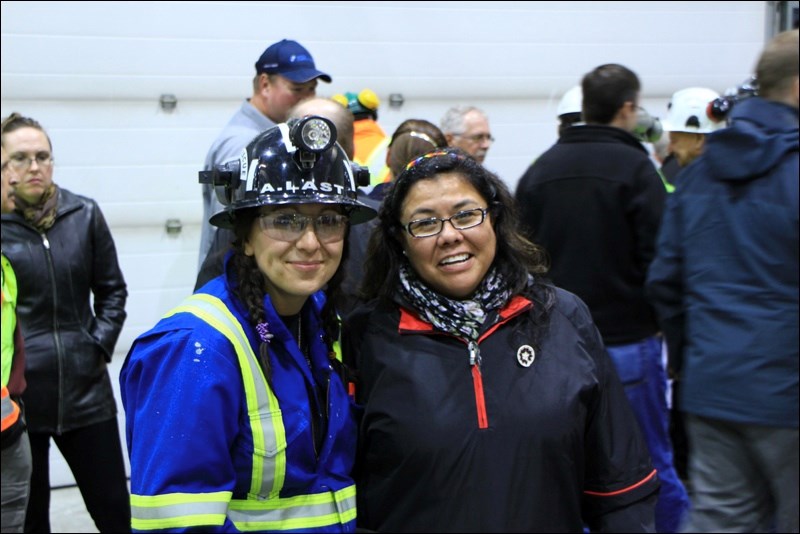In 2013, at the height of the Idle No More protest movement, Hudbay found itself mired in controversy.
Mathias Colomb Cree Nation, a small native band based in Pukatawagan, declared the company in breach of treaty law by opening its Lalor and Reed mines near Snow Lake without First Nations consent.
The powers that be (and much of the public) sided with Hudbay and mining carried on as planned.
The episode may have soured some First Nations people on Hudbay, but it hasn’t dampened the company’s enthusiasm for bringing more Aboriginals – perhaps a lot more – into the workforce.
“We find that building familiarity and understanding is what we need to accomplish,” says Rob Winton, vice-president, Manitoba Business Unit for Hudbay. “If you don’t work in a sector, you might know what it does in the broadest sense but not have much familiarity with all the aspects and details of it. I don’t think that’s unusual or unique to First Nations. But because we want to provide opportunity for Aboriginal people to be part of Hudbay, we’re trying to bridge that gap. We want them to see and believe that Hudbay is an option.”
To that end, Hudbay employs a series of initiatives designed to fashion a workforce that is more demographically reflective of its northern Manitoba base.
As one example, the company has collaborated on a training program, known as Introduction to Industry, to engage job-seekers from Opaskwayak Cree Nation (OCN) near The Pas.
At the core of Introduction to Industry is a comprehensive partnership involving Hudbay, OCN, University College of the North and Northern Manitoba Sector Council, made up of Hudbay and other industrial players in the region.
Also on board are two government-funded training initiatives, Workplace Education Manitoba and Workplace Essential Skills Training, better known as WEST.
Winton says the partners are now working to improve the impact of the four-month program, which last year involved 37 students.
Winton refers also to the Northern Manitoba Sector Council’s apprenticeship program to help Aboriginals from northern Manitoba achieve trade certification.
Of 200 applicants, 35 were chosen to begin apprenticeships in 2014.
“Over the course of four years, apprentices will spend two months of each year in in-class technical training and 10 months on the job,” says Winton, adding that Hudbay supports the program by providing job placements.
Further to that, Winton says Hudbay is building a partnership with the Flin Flon Aboriginal Friendship Centre and views the Flin Flon-based Northern Manitoba Mining Academy as an avenue for skills development.
In addition to potential direct employment for Aboriginals, Winton says Hudbay is helping First Nations businesses get onto the bidders’ list to provide contract services to the company.
“That way, when opportunities arise, they are in the pool,” he says. “It also lets us go out and procure services. We have the ability to target opportunities in some instances where that’s a viable option.”
Internally, Hudbay has since 2012 employed a full-time Aboriginal Liaison Officer (ALO) to coordinate efforts and facilitate dialogue with First Nations communities.
“We’re in regular contact through meetings, school presentations, open houses and mine tours,” says Winton. “We’re also in the development stage of working on joint initiatives related to employment.”
Winton says the ALO also plays a mentoring role with new and existing Aboriginal employees.
“Some of our Aboriginal employees have been at Hudbay for 10, 15 or even 20 years,” he adds. “We’re working to create mentoring relationships between them and new hires as well.”
To ensure a proper understanding of First Nations culture, Hudbay managers have participated in workshops that cover historical and contemporary issues relating to Aboriginal people in Canada.
“Every workforce is made up of different groups with different values, expectations and life experiences,” Winton says. “Our managers benefit from having insight into that.”
Successful?
Whether Hudbay has been successful in incorporating Aboriginals into its workforce is open to interpretation.
Of Hudbay’s 1,460 northern Manitoba employees, 190 – or 13 per cent – have self-declared as Aboriginal. The actual number could be higher given that self-declaration is by law voluntary.
On the one hand, that figure is nearly double the percentage of Aboriginal people working in the Canadian mining industry as a whole. As of 2012, that figure stood at 7.5 per cent, according to the Mining Association of Canada.
On the other hand, Hudbay’s figure does not mirror the demographic makeup of the region in which the company’s Manitoba division operates.
According to Statistics Canada, 19 per cent of residents in Flin Flon (Manitoba portion only), Creighton and Denare Beach were Aboriginal as of 2011.
Anecdotal evidence suggests the actual figure is notably higher and growing. Figures for Snow Lake are not available.
Just last year, David Garofalo, president and CEO of Hudbay, predicted the company’s Manitoba workforce would in time be more than half Aboriginal.
“Inevitably, given the demographics in northern Manitoba, I would say in due course the majority of our workforce will have to come from First Nations,” Garofalo told The Reminder. “So it is absolutely in our economic interests, and theirs, to have a very strong relationship.”
Winton did not put a percentage on Hudbay’s future Aboriginal workforce, but he does anticipate it will go up.
“Hudbay prioritizes hiring people from nearby communities, and, when necessary, help them gain the skills they need to qualify for jobs with us or in the larger employment market,” he says. “In Manitoba, we are partnering with several organizations to recruit and train local Aboriginal candidates for jobs. So it’s reasonable to expect Aboriginals will increasingly become part of Hudbay’s workforce.”
Like Garofalo, Winton agrees with the importance of pursuing additional Aboriginal employees.
“Hudbay’s success is determined in part by the success of the communities around us and of the people who live in those communities,” Winton says. “One of the challenges of mining in a remote or distant location is attraction and retention. It’s common sense to develop your workforce with the people already living where you’re working.”




